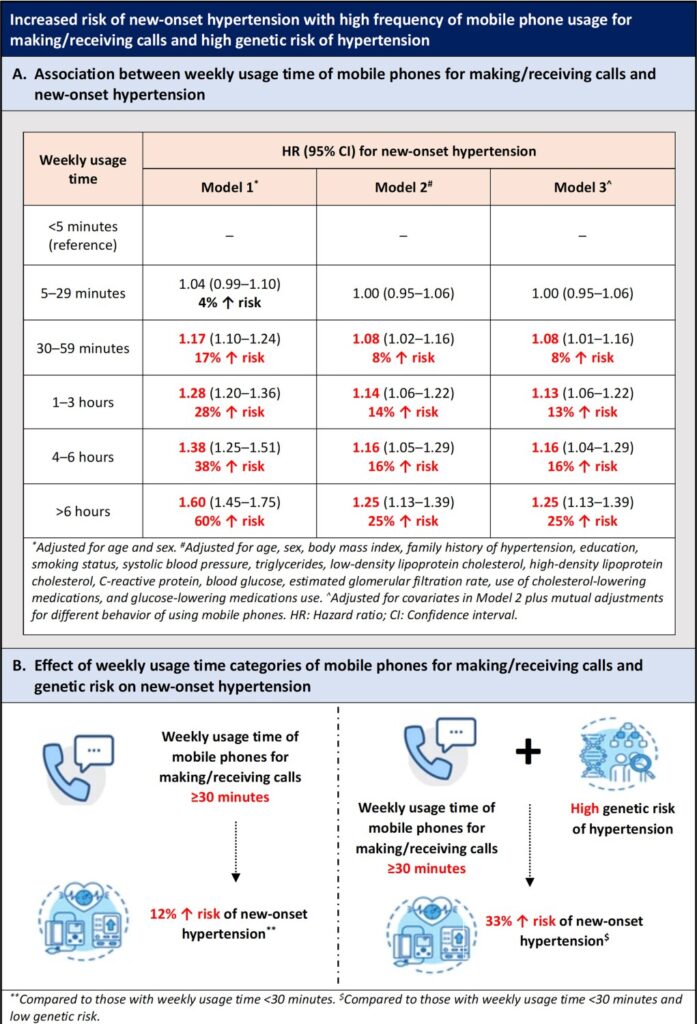
A study by Ye Z et al., recently published in the “European Heart Journal – Digital Health”, reported a significant association between longer weekly usage time of mobile phones for making/receiving calls (≥30 min) and higher (12%) risk of new-onset hypertension. This association was greater among those who had higher genetic susceptibility to hypertension. In the general population, reducing the time of mobile phone usage for making/receiving calls can play a role in primary prevention of hypertension.
This large, population-based prospective cohort study included participants from the UK biobank (n = 2,12,046; mean age: 53.7 years), without prior hypertension and with complete information on mobile phone usage behaviors regarding making/receiving calls (mobile phone users were defined as those using a mobile phone at least once a week). The median follow-up duration was 12 years. The primary outcome was development of new-onset hypertension based on medical history and linked to hospitalizations.
Hazard ratio (HR) and 95% confidence interval (CI) were used to assess the relationship of mobile phone users (vs. non-users) with hypertension in the overall population. Associations of mobile phone usage length, weekly usage time of mobile phones to make/receive calls, and use of handsfree device/speakerphone to make/receive calls, with new-onset hypertension in mobile phone users was also computed. Weekly usage time of mobile phones <30 minutes (vs. ≥30 minutes) with low genetic risk was used as a reference to evaluate the joint effect of weekly usage time of mobile phones for making/receiving calls and genetic risk of hypertension. The results are summarized below:
- New-onset hypertension was reported in 6.6% of the participants. A significantly higher risk (7%; HR 1.07, 95% CI 1.01 –1.12) of new-onset hypertension was reported in mobile phone users.
- Among mobile phone users, there were significantly higher risks of new-onset hypertension in participants with a weekly usage time of 30–59 minutes, 1–3 hours, 4–6 hours, and >6 hours for making/receiving calls compared with those with a weekly usage time of <5 minutes (p for trend <0.001; Graphic A).
- Compared with participants with a weekly usage time of mobile phones <30 minutes, significantly higher risk (12%) of new-onset hypertension in those with a weekly usage time ≥30 minutes (Graphic B).
- Highest risk of new-onset hypertension was observed in participants with a weekly usage time of mobile phones for making/receiving calls ≥30 minutes and high genetic risk of hypertension compared with those with a weekly usage time of mobile phones <30 minutes and low genetic risk (Graphic B).
- Length of mobile phone use and handsfree device/speakerphone use for making/receiving calls was not significantly associated with new-onset hypertension.

Clinical implications
- This was the first study to address the knowledge gap regarding the relationship between mobile phone use for making/receiving calls and risk of new-onset hypertension by considering mobile phone use for making/receiving calls and its usage frequency together.
- This study highlighted that the effect of mobile phone usage on risk of hypertension depended on the frequency of mobile phone usage for making/receiving calls rather than the length of using it.
- It was the first study to investigate the joint effect of weekly usage of mobile phones for making/receiving calls and genetic risks of hypertension on new-onset hypertension, emphasizing that the highest risk of new-onset hypertension was reported among those with both longer weekly usage time of mobile phones for making/receiving calls and high genetic risk.
(Source: Ye Z, Zhang Y, Zhang Y, Yang S, Liu M, Wu Q, Zhou C, He P, Gan X, Qin X. Mobile phone calls, genetic susceptibility, and new-onset hypertension: Results from 212 046 UK Biobank participants. European Heart Journal – Digital Health. 2023. Doi: 10.1093/ehjdh/ztad024)
